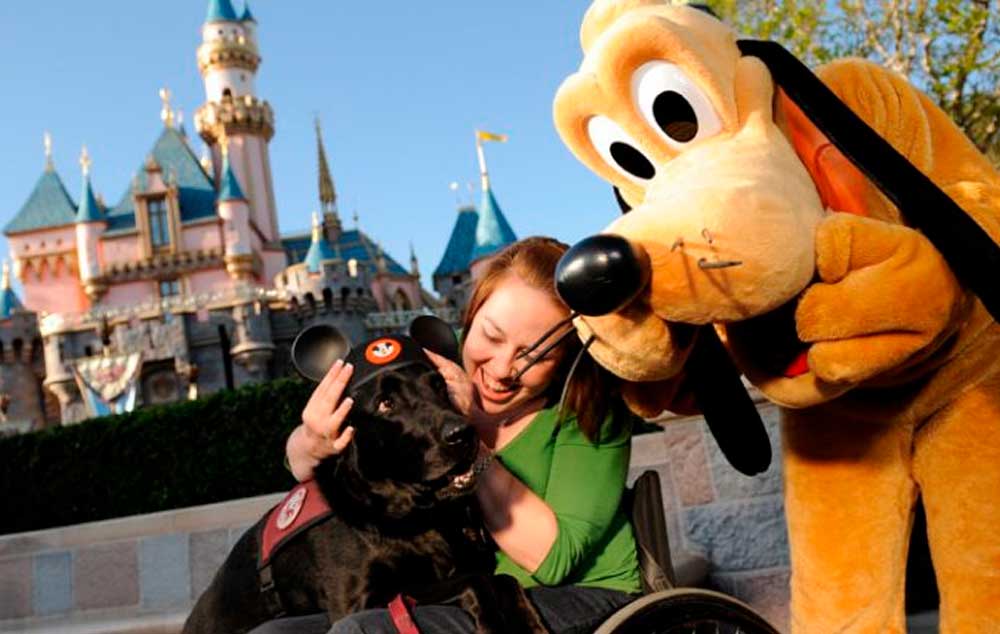
The Disney Difference For Guests with Disabilities
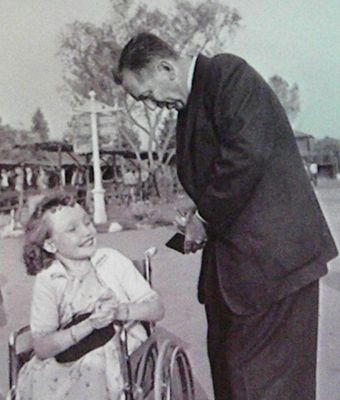 Walt signs an autograph book for a young guest. Photo part of Disney’s Guest with Disabilities presentation.
Walt signs an autograph book for a young guest. Photo part of Disney’s Guest with Disabilities presentation.
The other day I was a third-party participant to a conversation between two individuals who were very much “in the know” about attractions in the Orlando area. They were discussing how long the Wizarding World of Harry Potter would hold for Islands of Adventure at the Universal Resort. Neither really had a definitive answer. And neither do I. Nor can I really say just how successful the Fantasyland Forest addition will be for the world’s most popular theme park of all when it comes on board in 2012.
Building exciting new rides and attractions is an important component to any theme park strategy. You can’t compete without doing so. But it isn’t the only strategy. Often one of the most successful ways to build attendance is by focusing on niche markets. Walt Disney understood this in the early days, when Disneyland first introduced events like Grad Night. The Disney Vacation Club and ESPN Sports Complex are other examples of focusing on niche markets.
Your organization may not target to markets focused on baseball or time shares, but we all have an important opportunity when it comes to serving guests with disabilities. Many may consider this to be a small, even fairly insignificant market in terms of size. But a closer look at U.S. Census numbers in 2006 indicate that nearly 17 percent of Americans 16 years of age and older are disabled. That’s 38.5 million Americans. Add their traveling friends and family, and you realize that you can’t do enough to cater to this important market.
Disney knows this, and in catering to the needs of guests with disabilities, they create a definitive Disney difference from their competitors.
Of course all resorts and parks are required to be ADA compliant, as are any public facilities. Disney does this as well with curb cuts, companion restrooms, and lower level sinks/drinking fountains. They not only provide a better experience for guests with disabilities, but also in catering to smaller children.
But the Disney Difference is that they go so much further in its approach. Larry Goldberg, director of media access at WGBH Boston, a pioneer in developing multimedia and new technologies that make media accessible for the disabled, noted: “I know of no other public space in this country—or anywhere else for that matter—that is as welcoming and accessible to people with disabilities as Disney’s theme parks.”
Disney’s increased emphasis began when Epcot opened in 1982 with the addition of they assisted-listening devices for many of their filmed attractions. In 1996, reflective captioning and closed caption was added to attractions like the Country Bear Jamboree and the Hall of Presidents.
Today, focusing on guests with disabilities takes on many forms. For instance:
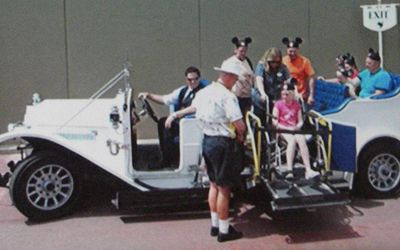 You’ve seen areas set aside for guests with disabilities to view the 3 p.m. parade. Did you know the vehicle created a couple of years ago for the family of the day in the 3 p.m. parade has the ability to load guests needing mobility assistance?
You’ve seen areas set aside for guests with disabilities to view the 3 p.m. parade. Did you know the vehicle created a couple of years ago for the family of the day in the 3 p.m. parade has the ability to load guests needing mobility assistance?
New attractions at Disney seek to accommodate guests with mobile impairments. For example, Toy Story Mania has a special location for wheelchair loading, that allows those guests who have such needs to take their time to board, without interrupting the flow of the remaining patrons.
In retrofitting current Disney attractions, you’ve probably seen the boats designed to accommodate wheelchair parties at “it’s a small world” and Pirates of the Caribbean. But have you seen how the train at Big Thunder Mountain Railroad has been retrofitted?
Outside Expedition Everest is a Transfer Practice Vehicle for guests to see how they would transfer into the train. They can then go through the stand-by queue, or obtain a FASTPASS and enter that way before entering the Transfer Access Vehicle.
You find that same focus at the Disney resorts. For many years there have been facilities for guests with disabilities. Such facilities have provided such features as phone text, and visual indicator door knocks. But did you know the Disney Cruise Line also offers accessible staterooms?
Newer pools at Bay Lake Tower or Disney’s Animal Kingdom Lodge have introduced sloped-entry pools. But for years, Disney has been working on perfecting sand and aquatic wheelchairs. Those vehicles are available in even remote locations such as Castaway Cay.
In for a round of golf? There’s even a cart especially designed to support those with mobility impairments.
Assistive Technology handheld devices were first introduced in 2001 with One Man’s Dream at Disney Hollywood Studios. These complimentary devices are being reintroduced this week with a new interactive audio menu, that lets guests choose the type of information they would like to receive about outdoor areas, from architectural elements to the location of the nearest restroom.
- Detailed descriptions for more than 50 attractions;
- Amplified audio for most theater-type attractions for guests with mild to moderate hearing lost;
- Handheld captioning that enables guests to read captions while enjoying specific rides; and
- Activates closed captioning in preshow areas where television displays narrate the upcoming experience.
In building these devices, Disney didn’t work in a vacuum. They worked with organizations such as the American Council of the Blind to test these products and to gain input. And Walt Disney World isn’t just offering this, or being on the edge of offering these types of devices. They are being the pioneers in providing more meaningful guest experiences for those with disabilities. They are the ones creating the patents, and are even licensing the products to other retail and commercial venues, such as the Coca Cola Museum and the Dallas Cowboys Stadium.
The result? Well this is what one annual passholder with visual impairments stated: “From the moment I stepped into the lobby of the building [Imagination Pavilion, Epcot], I knew the future of how I enjoy attractions had simply changed forever.”
Disney is bringing these same technologies to their other sister parks. Disneyland will receive the assistive technology handheld experience come 2011. And, recently, Disneyland Hong Kong won the Barrier-Free Public Toilet Recognition Award. No it wasn’t a golden toilet. But it was a recognition that Disney is barrier-free access in places where such attention hasn’t traditionally being given.
Attending to the special needs of guests, that’s the Disney Difference. Is it enough to capture market share this year over Harry Potter? Perhaps not. But it can mean a lot to building long-term customer loyalty. And long-term loyalty is what makes the difference between world-class organizations and the rest.
So if you want to be world-class, consider the following:
- Do you look at handling guests with disabilities as a liability requirement or as an opportunity?
- Are you seeking input and feedback from organizations and individuals with disabilities about how you could improve your own products and services?
- Do you seek to separate yourself from the competition by going above and beyond what is required by ADA standards?
Next time you’re at Walt Disney World, take another look at how Disney provides a meaningful experience for those guests with disabilities. You can learn a lot about how you serve those around you.
Source: Mouse Planet
Compartilhe
Use os ícones flutuantes na borda lateral esquerda desta página
Siga-nos!
Envolva-se em nosso conteúdo, seus comentários são bem-vindos!
2 Comentários
Enviar um comentário
Você precisa fazer o login para publicar um comentário.
Artigos relacionados
Teleton AACD. A pessoa com deficiência como protagonista.
Teleton AACD. A pessoa com deficiência como protagonista. Uma iniciativa internacional abraçada pelo SBT no Brasil.
Acessibilidade no ESG. Equipotel aborda o tema para o turismo.
Acessibilidade no ESG, para o mercado do turismo. Equipotel aborda a importância da inclusão da pessoa com deficiência.
Morte Sobre Rodas. Filme inclusivo foi candidato ao Oscar.
Morte Sobre Rodas. Dois protagonistas do filme, são pessoas com deficiência, um usuário de cadeira de rodas e outro com paralisia cerebral.

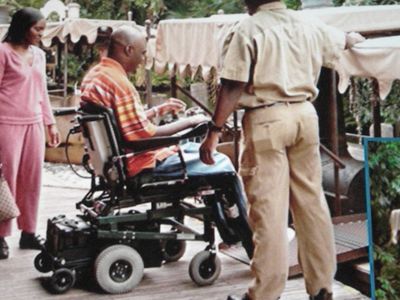
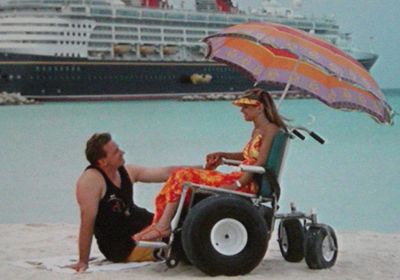
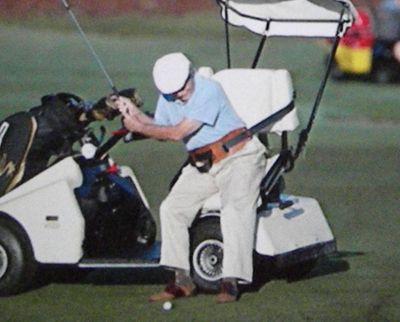
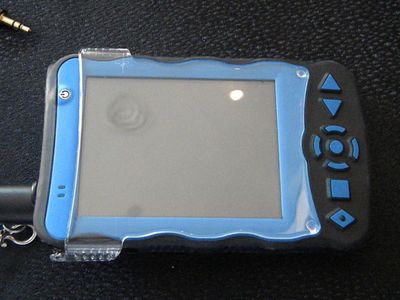


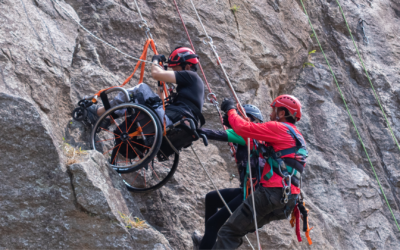
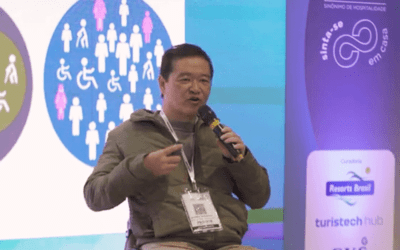
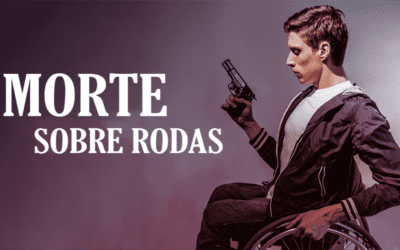
Oi, RIcardo. Primeiro, parabéns pelo blog! Segundo, você conhece The Unofficial Guide Walt Disney World? Acho muito interessante e útil, mas queria que tivesse um para Guests with Disabilities! Se souber de coisa parecida, nos avisa. Abraço
Nas viagens que agenciamos, o visitante com deficiência tem todo o suporte para desfrutar da Disney com acessibilidade.